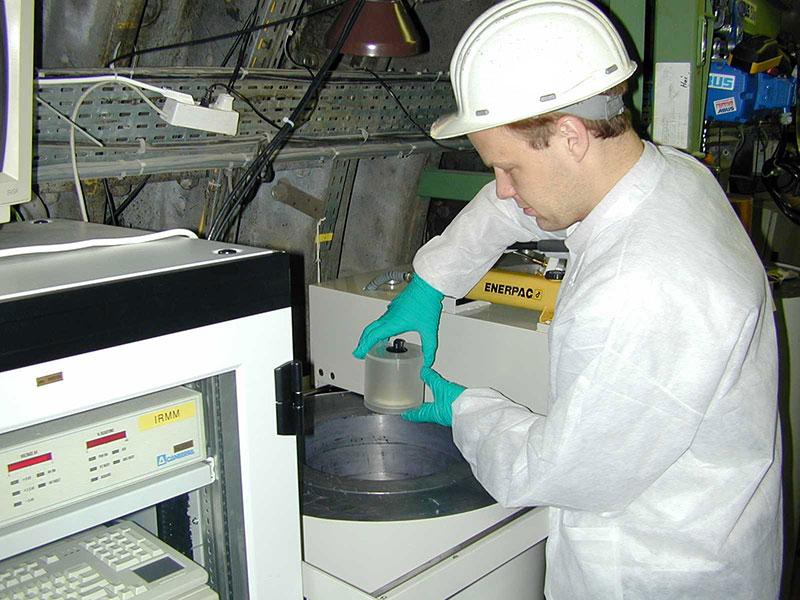Details
- Status
- Closed
- Reference
- 2019-2-RD-EUFRAT-HADES
- Publication date
- 2 February 2022 in Geel, Belgium
- Opening date
- Deadline model
- Single-stage
- Deadline date
- 1 November 2019, 01:00 (CET)
Description
JRC operates a laboratory for ultralow-level radioactivity measurements inside the 225 m deep underground laboratory HADES, which is located at the premises of the Belgian Nuclear Research Centre. In HADES, the muon flux (secondary cosmic rays) is a factor of 5000 lower compared to above ground and the flux of protons, neutrons and electrons is reduced to an insignificant level. This reduction of the cosmic ray flux makes the background in gamma-ray spectrometry measurements significantly lower compared to above ground. Therefore it is possible to detect very low amounts of radioactivity (sub mBq range). Eleven specially designed high purity germanium detectors are used for the measurements. There is also a scanning station by which the homogeneity of deadlayers in HPGe-detectors can be studied.

Priority topics of HADES
Ultra low-level gamma-ray spectrometry for:
- Characterisation of reference materials for their radioactive content: e.g. materials used for environmental monitoring, food control, radioactive waste management, earth sciences, archaeology, biology, dating, electronics, radioecology...
- Tracing processes in nature like ocean currents (input to climate change modelling) and uptake in the food chain.
- Tracing anthropogenic activities from nuclear activities.
- Radioecological studies
- Support to European NORM industry.
- Quality control (checking blanks and low-level samples).
- Basic physics experiments in astrophysics and neutrino physics (e.g. search for neutrinoless double beta decay and other rare processes).
- Material selection and detector testing for underground experiments.
- Study and measurements of rare nuclear decays
- Testing of detectors and methods for low-level applications
- Materials selection for radiopure detectors
- Storage and testing of radiopure components
- Characterization of HPGe-detectors for deadlayer homogeneity
Definition and conditions of access
Access to the research infrastructure is granted on the basis of Access Units
For HADES, the Access Unit corresponds to a 'Measurement week', i.e. one week of measurement on one of the instruments in HADES. For each approved experiment, HADES will offer the best possible measurement conditions according to the specifications of the users and guaranteeing an optimal data output that is available at the given time.
All users will be requested to complete and deliver safety and security-related documents to get access to the nuclear facilities at HADES. Approval of access is subject to the rules of the European Commission, the Joint Research Centre and the Belgian authorities. Submission of documents should therefore be started in time to allow completion of the approval procedure well before the start of the experiment.
- Estimated total number of Instrument weeks allocated to the call: 100
- Average number of Instrument weeks per Project: 20
- Estimated costs excluding consumables and expenses:
- Research infrastructure operated by JRC staff: 0 € / Measurement week
- Research infrastructure operated by users: Not possible
Allocation of intellectual property rights:
The JRC and the entitled party (person or organisation that has been granted access) become co-owners in equal shares of all raw data, treated data and documentation data developed with respect to the access.
Eligibility criteria
- The Lead User Institution and User Institutions ( see definitions in the Framework) must be from an EU Member State or country associated to the Euratom Research Programme (Switzerland and Ukraine as of July 2019).
- The Lead User Institution must be from a university, research or public institution, or from a Small-Medium-Enterprise (SME).
- Ethical considerations in accordance with EU Law, in particular Art. 19 of Regulation (EU) 1291/2013, and applicable laws and regulations in the EU Member States.
- The proposal submission form is complete and complies with the instructions.
Selection criteria
Any proposal will be scrutinised in accordance with weighted selection criteria such as:
- Scientific implementation
- Access to SMEs and new Users
- Strategic relevance to the JRC
- Strategic importance for Europe
How to apply
The proposal must be prepared by using the template given in Annex 3.1 of the Framework.
During preparation of the proposal, applicants are encouraged to:
- Read the "Framework of Access to Joint Research Centre physical Research Infrastructures" and its annexes.
- Contact the research infrastructure at JRC-OPEN-EUFRAT@ec.europa.eu to assess feasibility aspects related to the capacity of the research infrastructure.
For HADES the Lead User must also fill in the EUFRAT (HADES) Facility Specifications Form following the instructions at the end of the form when submitting the proposal.
The proposal should be submitted to JRC-RI-OPEN-ACCESS@ec.europa.eu by the closing date of the call.
Communication of the assessment of proposals:2020-01-06 00:00:00
